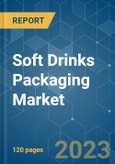The soft drinks packaging market is expected to register a CAGR of 3.96% over the forecast period. Increasing disposable income, growing economies, and demand for ready-to-use drinks are expected to drive market growth.
In July 2022, LinkOwens-Illinois Inc. announced the building of a new greenfield glass plant in Bowling Green, KY. In line with strong consumer trends toward healthy, recyclable, and sustainable food and beverage packaging. The company plans to invest up to USD 240 million in several waves of expansion over time, adding about 140 additional jobs to the area.
This product will be delivered within 2 business days.
Key Highlights
- The market for carbonated soft drinks (CSD) has matured within the beverage industry. It has undergone several changes recently, and it is anticipated that this flux will last for some time. Consumers have been becoming more and more health-conscious in recent years. Customers are spending more money on products that replenish them and are safe to ingest.
- Customers seek healthy products with a variety of flavor options. Furthermore, to accommodate these expectations, businesses are introducing additional products. Consequently, more chances will arise for the packaging industry for these items.
- The economies of developing nations like China and India are expanding, increasing the disposable income available to the general public. Ready-to-use packaged drinks are currently more in demand from consumers.
- The use of non-biodegradable plastics is subject to stringent government regulations preventing businesses from using other eco-friendly packaging materials. Due to their outstanding prices, these items reduce the profit margin, ultimately impacting the soft drink packaging market.
- Lockdown procedures in response to the COVID-19 pandemic emergency have severely disrupted the supply chain and reduced consumer disposable income. The carbonated soft drink industry will undoubtedly be impacted by the solid recessionary repercussions and new health and fitness concerns in the post-COVID-19 age.
Key Market Trends
Plastic to Account for the Largest Market Share
- Since plastic packets are lighter and more comfortable to handle than other items, consumers have been seen to prefer them over other products in the soft drink business. Additionally, the big manufacturers favor plastic packaging options due to the much cheaper production costs.
- Government laws and customer demand, which are causing manufacturers to seek out packaging options that are biodegradable or made from sustainable sources, are predicted to present difficulties to the industry.
- In recent years, many plastic products have also been recycled and utilized again. Another factor boosting the market share of this sector is the diversity of plastics available for packaging, including PVC, PE, PP, PS, PET, and nylon.
- PET bottles are one of the most economical packaging options for soft drinks because of their small weight, which lowers storage and shipping expenses. However, shortly, the demand for freshly manufactured goods by consumers could have a detrimental effect on expanding the worldwide soft drink packaging industry.
- The resins used in PET bottles to pack carbonated drinks are of exceptional quality. The PET bottles have to be extremely strong to contain the internal pressure of CO2 without distortion and expansion.
Asia-Pacific to Witness Fastest Growth
- Asia-Pacific has a sizable customer base and several economies that are expanding quickly. However, regional packaging preferences vary widely; therefore, adopting regional and application-specific solutions is anticipated to improve product transportation. Additionally, manufacturers are actively implementing sustainable packaging standards due to rising pressure from consumer advocacy organizations, the government, and consumers.
- In Asia, Japanese consumers have the highest per capita income. This, together with the country's elderly population's growth and the new functional food labeling system, has made room for luxury available soft drink brands, particularly those that target older consumers with health claims.
- In India, one of the sectors where significant investments are being made for growth and technological advancement is the beverage business. The country's soft drink packaging sector has recently seen a substantial trend away from the common multi-serve presentations prevalent in all soft drink categories in favor of more miniature 'on the go' packs and, even more critical, 'family packs.'
- Additionally, for several macro reasons, the non-alcoholic beverage market in the region is among the fastest-growing markets globally. The current low per capita consumption indicates a huge future volume growth potential.
Competitive Landscape
The availability of several players providing soft drinks packaging solutions has intensified the competition in the market. Therefore, the market could be more cohesive, with many companies developing expansion strategies. Some prominent market players are Amcor PLC, Toyo Seikan Group Holdings Ltd, and Graham Packaging Company.In July 2022, LinkOwens-Illinois Inc. announced the building of a new greenfield glass plant in Bowling Green, KY. In line with strong consumer trends toward healthy, recyclable, and sustainable food and beverage packaging. The company plans to invest up to USD 240 million in several waves of expansion over time, adding about 140 additional jobs to the area.
Additional benefits of purchasing the report:
- The market estimate (ME) sheet in Excel format
- 3 months of analyst support
This product will be delivered within 2 business days.
Table of Contents
1 INTRODUCTION
4 MARKET INSIGHTS
5 MARKET DYNAMICS
6 MARKET SEGMENTATION
7 COMPETITIVE LANDSCAPE
Companies Mentioned (Partial List)
A selection of companies mentioned in this report includes, but is not limited to:
- Amcor PLC
- Toyo Seikan Group Holdings Ltd
- Graham Packaging Company
- Ball Corporation
- Owens-Illinois Inc.
- Pacific Can China Holdings Limited
- Crown Holdings Incorporated
- CAN-PACK SA
- CKS Packaging Inc.
- Refresco Group NV
- Tetra Pak Inc.
- Ardagh Group SA
Methodology

LOADING...










